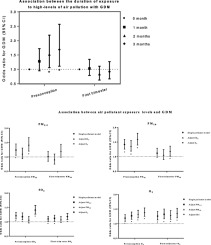当前位置:
X-MOL 学术
›
Environ. Res.
›
论文详情
Our official English website, www.x-mol.net, welcomes your
feedback! (Note: you will need to create a separate account there.)
Relationship betweentemporal distribution of air pollution exposure and glucose homeostasis during pregnancy.
Environmental Research ( IF 7.7 ) Pub Date : 2020-04-03 , DOI: 10.1016/j.envres.2020.109456 Mengnan Yao 1 , Yang Liu 1 , Dan Jin 2 , Wanjun Yin 2 , Shuangshuang Ma 2 , Ruixue Tao 3 , Fangbiao Tao 1 , Peng Zhu 1
Environmental Research ( IF 7.7 ) Pub Date : 2020-04-03 , DOI: 10.1016/j.envres.2020.109456 Mengnan Yao 1 , Yang Liu 1 , Dan Jin 2 , Wanjun Yin 2 , Shuangshuang Ma 2 , Ruixue Tao 3 , Fangbiao Tao 1 , Peng Zhu 1
Affiliation

|
BACKGROUND
Mounting evidence has demonstrated that air pollution exposure is associated with the increased prevalence of gestational diabetes mellitus (GDM). However, the long-term exposure effect and the time window of the maximum effect of these air pollutants on GDM and glucose homeostasis during pregnancy are unclear.
METHODS
We conducted this study on 5427 nondiabetic pregnant women who were admitted from three hospitals in Hefei City, China, between 2015 and 2018. The data regarding the average exposure to particulate matter (PM), sulfur dioxide (SO2), and ozone (O3) were estimated in a fixed monitoring station in Hefei. We used logistic regression and multiple linear regression to assess the effects of air pollutants on GDM and glucose homeostasis.
RESULTS
Of the 5427 participants, 1119 (20.6%) had GDM. We found prepregnancy exposure to air pollutants was associated with the risk of GDM in the single pollutant model [odds and 95% confidence interval (CI) of GDM for an interquartile range (IQR) increase was 1.24 (1.06-1.45) for PM2.5, 1.42 (1.26-1.59) for PM10, 1.21 (1.10-1.33) for SO2 and1.19 (1.08-1.31) for O3]. The risk of GDM before pregnancy was higher with long-term exposure to high-concentration pollutants compared with the risk in pregnant women who were not exposed to high-concentration pollutants (χ2 = 41.52, p for trend <0.0001); the ORs and 95% CI values for the exposure times of 1, 2, and 3 months were 1.28 (0.96-1.72), 1.52 (1.06-2.19), and 1.69 (1.11-2.57), respectively. The results showed a positive effect of exposure to higher-concentration air pollutants 1 year before pregnancy on glucose homeostasis during pregnancy. The time windows of the maximum effect of PM2.5, PM10, SO2, and O3 on GDM were different. The time windows of the maximum effect of PM2.5, PM10, and SO2 were 6 months, 5 months, and 1 month before the last menstrual period (LMP) and 3 months after the LMP, respectively. The time windows of the maximum effect of air pollution on glucose homeostasis indicators from the 2-h 75-g oral glucose tolerance test were similar to the abovementioned results.
CONCLUSIONS
Prepregnancy long-term air pollution exposure was associated with a higher risk of developing GDM by affecting glucose metabolism. The time window of the maximum effect of PM on GDM and glucose metabolism indicators was observed earlier than that of SO2 and O3.
更新日期:2020-04-06











































 京公网安备 11010802027423号
京公网安备 11010802027423号